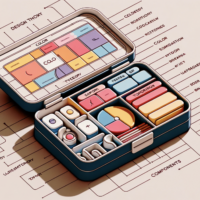The Evolution of Pixel Perfection in the Digital Landscape
The concept of “pixel perfect” web design has undeniably grown from an afterthought in the 1990s to a necessity now. In fact, I believe that Apple’s success with their mobile products and its sophisticated UI sparked this industry-wide change. Nowadays, designers must invest more effort into attaining pixel perfection not only for providing superior user experiences but also for staying competitive within the industry at large.
How the concept of pixel perfect design has changed over time and its impact on today’s digital industry
The phrase “pixel perfect” is pretty much ubiquitous now, but it wasn’t always. The phrase itself is straightforward and easy to understand. While it had a slow start, making things pixel perfect isn’t easy to actually do. These days it’s important to understand how this phrase affects careers in the digital landscape here and now.
The Early Days of Digital Design
I created one of my first websites in 1996. It was for a very popular jean company in South America. The website was rudimentary and at the time was their creative director. I was making my pivot to digital after receiving some very good advice.
The idea that things could be pixel perfect at that time wasn’t in the calculus for me. It was more like just getting things done well – not done perfect. Maybe this is your standard today. The standard was really no standard. Flash was everywhere.
The Shift to Pixel Perfection in the 2000s
In the 2000s things changed. The dot com bubble popped and online businesses were out of the business while others took the path of the tortoise and slowly expanded. The iPhone hadn’t yet come out.
Print at the time was seeing a contraction, but there were many designers that thought digital was a lost art. From their perspective one couldn’t really create something that lasted or was perfect online. I didn’t see digital that way. I saw an opportunity to touch many people more than the average print designer could.
There was a definite shift occurring circa 2005. As I recall CSS was becoming a little more robust and that was leading me to the inevitable pixel perfect vision of digital things. At the time, I was working in travel with one of the many sister companies of Expedia and our goal was to get close pixel perfect. But that was an internal goal. That wasn’t something the industry saw as important. That was something we did as a badge of honor. It was our craft that we cultivated.
The Impact of Apple on Pixel Perfection
I know. I get it, but Apple was always perfect right? Is that what you’re thinking? Or maybe another Tech firm or Agency or Game house was doing pixel perfection? Yes and no. I didn’t see agencies in the South East even have processes that could lead to pixel perfection in their ops. People were designing in code or in Photoshop and not iterating and not thinking about the why let alone pixel compliance.
Things start speeding up 2007-2010 after the first iPhone drops. Apple got its mojo back. Thanks to them and a ton of well-designed products in market. The idea that a “web designer” could present one thing to stakeholders and deliver something very different was becoming a risky proposition.
The Democratization of Design
Design was being democratized before our eyes. It wasn’t just about making software like Microsoft had done so well in the past. It was about creating pixel perfect user experiences with software at its DNA.
The Importance of Pixel Perfection in Today’s Digital Landscape
Today most tier 1 agencies have specific procedures to measure pixel compliance. Whether it be good old Photoshop or custom overlay tools, agencies know what they want. And agencies serve important clients and do so globally.
I remember taking a call from an agency partner of a great firm that specialized in WordPress. I delivered work within a 3-pixel compliance for a household name client. And she told me if did that again I would be out of a job. That’s right. First and last warning.
Her standards back then were way higher than mine – by 3 pixels. She was unapologetic. It changed my view of myself and my craft. It leveled me up. If your standards are low, maybe it’s time to raise them. We’re talking about your craft, not playing at a hobby.
The Future of Pixel Perfection
Today the top performers in the S&P are not only pixel perfect but they are doing work from design systems. Pixel perfect is the standard. It’s not optional if you want to get to the next level. The digital landscape is constantly evolving and it’s essential to stay ahead of the curve and strive for pixel perfection in your work. It’s not just about creating visually pleasing designs, but it’s also about creating user experiences that are seamless and intuitive from design to code.
The concept of pixel perfection has come a long way since the early days of digital design. It’s no longer just about getting things done, but about creating high-quality, pixel-perfect designs that meet the standards of today’s digital landscape. As designers, it’s important to stay informed and strive for pixel perfection in our work, to ensure that we are delivering the best possible user experience and standing out in a competitive industry.
The impact of Apple on the push for pixel perfection in the industry is undeniable and it has set the standard for what is expected in the digital world. It’s not just about following the latest trends, but about constantly pushing ourselves to improve and refine our craft. So let’s embrace the challenge and strive for pixel perfection in our work.




